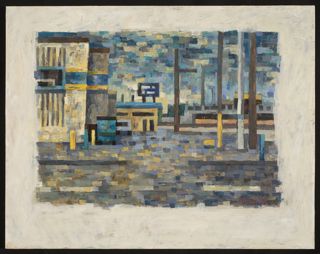I am pleased to announce the work of artist Julia Hensley now on display at Sightline Institute through the end of June. “Urban Perspective: City Views” is a collection of mostly local urban landscapes in abstraction and multiple media: oil, acrylics, and gouache-on-paper collage. An excerpt from Julia’s statement about this body of work:
I love coaxing a composition from the banal chaos of urban detail – the more obscure and unpromising the corner of the city, the better. My vision is an invented perspective informed by cubism, pixelation, quilts, and Mondrian’s grids, in which the city is seen as if from above and head on simultaneously…The flattening effect of the verticals and horizontals also serves my interest in reality as illusion – an idea reinforced by years of painting scenery for theater and television…I invite the viewer to freely interpret place and mood.
Born in South Africa, Julia received her BFA at Boston University. She currently lives in Seattle and is a talented painter and collage artist, as well as a much respected and beloved teacher of drawing and painting. She is represented by Sunne Savage Gallery in Winchester, Massachusetts. Keep up with Julia on her painting blog, her art discussion blog, and her journal.
You can view a slide show of most of the works on display, but be sure to see them in person at Sightline! All 13 pieces are available for purchase.
What thoughts about sustainability are inspired by this art? Share yours in a comment.

Julia,
I LOVE this painting, despite the center line of the street, the foreground feels like water in which the buildings et al float…the sustainability ideas it evokes for me are the preciousness of clean air and water and right relation to them both. I’ll get down there to see your work – with pleasure.
Selina
————–
Emailed to the artist by Selina Sweet and posted here with her permission.
I will be sad to see the pieces go at the end of the month. They’ve prompted me to think about art and creativity, and their role in sustainability. At first, they might seem tangential, but I see the arts as perhaps the ultimate destination of the movement toward sustainability. The arts, in general, involve a tremendous amount of value and an inconsequential quantity of resources. “Consuming” art — whether paintings, or photography, sculpture, music, dance, theater, film, poetry, literature — is a way in which we can add tremendous value to daily life, while consuming very few natural resources. “More fun, less stuff” is one definition of sustainability I made up in about 1990 (since turned into bumper stickers by my friends at the Center for a New American Dream). The arts embody that principle.
Alan, I’m glad you are enjoying the work and I think your idea has resonance far beyond this show. Thank you for expressing it here. One of the further thoughts it inspires for me is that, since a work of art is arguably incomplete till seen it also, importantly I think, promotes and invites communication and interaction between people. This could be a silent, private connection between creator and viewer, or a conversation between viewers, or a public discussion like this one. If the experience of viewing art is as you point out highly rewarding while requiring few resources, then it becomes not only an elegant and sustainable form of enrichment but a high form of communication and interaction. And the more of that, the better.
I like these a lot. So many contradictions here that get the mind working: They’re free and fluid at the same time they’re meticulous and tightly crafted. They’re abstract and at the same time pictorial. Flat and layered.
And they make me think of the built environment in new ways–both fractured and coherent, beautiful and manufactured.
There were several of these that I’d like to have for my own!
Anna, thank you for your perceptive, receptive comments. I couldn’t ask for my work to be better seen and understood.